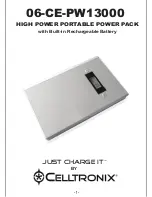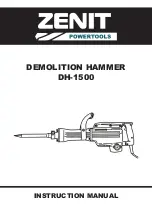
Page 13
X100 SERIES
INSTALLATION & OPERATING MANUAL
Manual No. x100-5a
x100-man-Rev5a-0214.indd
10.0 MAKING CONNECTIONS TO THE X100
10.1
DC Load Connections
The DC load distribution connections at the rear left of the unit are clearly marked
as follows:
10.1.1
Option A – 1-8 miniature circuit breaker.
Terminals marked 1-8 are used for breakers marked 1-8 respectively. Each
circuit has a FEED and a RETURN (RTN) connection. Terminals marked
9 and 10 are not used.
10.1.2
Option B - GMT Fuses.
Terminals marked 1-10 are used for fuse marked 1-10 respectively. Each
circuit has a FEED and a RETURN (RTN) connection.
10.1.3
Option C - 1-4 bulk circuit breaker.
To allow for the possibility of individual load circuits providing in excess of
30A this configuration uses two pairs of screw terminals linked together by
a small bus bar for each circuit. Terminals marked 1&2, 3&4, 5&6 and 7&8
respectively are used for Breakers 1 to 4 respectively. Terminals marked 9
and 10 are not used.
Note that in the case of -48VDC system the ‘feed’ terminals are at a negative potential
with respect to the ‘return’ terminals. In the case of +24VDC and +12VDC systems
the ‘feed’ terminals are at a positive potential with respect to the ‘return’ terminals.
When connecting to the DC load terminals it is important to ensure that the cables
used are adequately sized to carry the expected load current for the circuit in question.
The maximum current rating for the individual load terminals is 30A for options A
and B or 50A for option C, but where long cable runs to the load are expected care
should be taken to avoid unacceptable cable voltage drop; this is most likely to occur
at currents in excess of 20A if only a single feed and return cable are employed. It
is recommended that for circuits where a 20A or greater breaker is fitted pairs of
feed and return cables are installed.














































